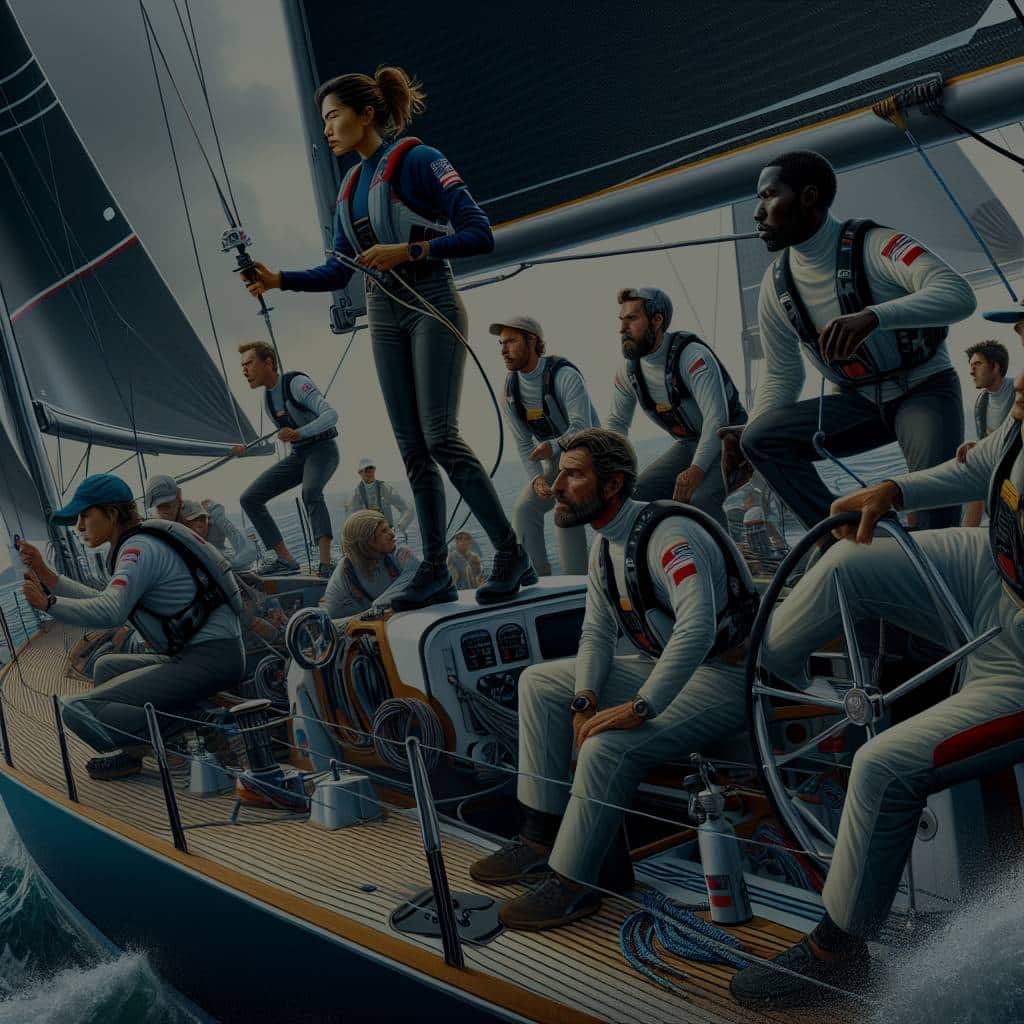What Are the Dynamics of Team Leadership in High-Pressure Sailing Competitions?

Sailing, often perceived as a solitary pursuit, couldn’t be farther from it when it comes to high-pressure competitions. The picture-perfect image of a lone sailor battling the elements on the open seas gives way to a dynamic, well-oiled machine of a team, working in perfect synchrony under a leader’s guidance on racing yachts. Team leadership dynamics in such a demanding environment are complex and fascinating. This article delves into the intricacies of these dynamics, their manifestation, underlying principles, and their critical importance to securing victory in high-stakes sailing competitions.
The Role of the Team Leader in Sailing Competitions
In the world of competitive sailing, the team leader’s role goes beyond merely steering the yacht. They are the pivotal point around which the entire team’s performance revolves. The team leader, or the skipper, not only has to be an adept sailor but should also possess the skills to lead, manage, and inspire the crew under extreme pressure.
A lire aussi : How to Balance Strength and Technique Training for Elite Judo Fighters?
One of the primary functions of the leader in a sailing competition is strategic decision-making. The skipper has to make critical choices, such as determining the course, adapting to changing weather conditions, or deciding when to change sails. These decisions, often made under tremendous pressure, can significantly impact the team’s performance and the race’s outcome.
Another crucial aspect of team leadership in sailing is communication. The skipper must ensure clear and effective communication among the crew, relaying commands, and feedback in real-time. At the same time, they must also foster an environment of mutual trust and respect, promoting a collective vision of success that motivates the team to perform at their best.
A lire aussi : How Can Virtual Coaching Platforms Support Aspiring Marathon Runners?
The Dynamics of Team Interaction
The heart of a sailing competition team’s success lies in its effective interaction, enabled and led by the skipper. The dynamics of team interaction in high-pressure sailing competitions are characterized by high levels of coordination, synchronization, and mutual support.
Coordination is the key to a well-functioning sailing team. Whether it’s changing sails, tacking, or jibing, every task on a racing yacht requires precise coordination among the crew members. The team leader plays an essential role in orchestrating this coordination, ensuring that each crew member knows their role and executes it flawlessly.
Synchronization is another hallmark of effective team interaction in sailing. The crew must operate as a single cohesive unit, with actions and movements perfectly timed to keep the yacht moving at optimal speed. The leaders’ role in fostering this synchronization cannot be overstated, as they guide the crew in maintaining rhythm and harmony in their actions.
The dynamics of team interaction also encompass mutual support. In the highly demanding environment of a sailing competition, crew members need to support and back each other, both physically and emotionally. The team leader plays a crucial role in encouraging this supportive culture, reinforcing the idea that every individual’s contribution is vital to the team’s overall success.
Harnessing Personalities and Skills
Successful team leadership in sailing competitions also involves harnessing each crew member’s unique personalities and skills. The team leader needs to understand the individual strengths and weaknesses of their crew members and tactfully deploy them in roles where they can contribute effectively.
Effective leaders know how to leverage the diverse talents within their team. They identify the natural leaders, the strategists, the doers, and the cheerleaders in their crew and align their roles to match these inherent skills. This not only optimizes the performance of the team but also fosters a sense of individual accomplishment and collective victory.
Understanding and managing the different personalities in the team is equally essential. The leader should be able to maintain a balance between the dominant and submissive personalities, ensuring that everyone has a voice and feels valued. They must also cultivate a positive team culture, fostering a sense of unity and camaraderie that propels the team towards a common goal.
Maintaining Morale and Motivation
Maintaining high morale and motivation levels is another vital aspect of team leadership in high-pressure sailing competitions. The extreme conditions, coupled with the high stakes of the competition, can easily lead to stress and burnout among the crew members.
The team leader plays a pivotal role here. They need to keep the morale high, motivate the crew, and ensure that the team spirit remains unbroken even in challenging situations. This involves recognizing and celebrating small victories, providing constructive feedback, and offering emotional support when needed.
In sailing competitions, motivation often comes from a shared desire to win. The leader should continually reinforce this collective ambition, reminding the crew of their shared goal and the importance of every individual’s contribution towards achieving it.
Dealing with Conflict and Pressure
In the heat of a high-pressure sailing competition, conflicts can easily arise among the crew members. Differing viewpoints, high stress levels, or simple misunderstandings can spiral into full-blown disputes if not managed promptly and effectively.
The leader must be adept at conflict resolution, addressing issues promptly, and ensuring they do not derail the team’s focus. They need to foster open communication, promote mutual respect, and ensure fair resolution of disputes.
Similarly, the leader must help the team cope with the immense pressure of sailing competitions. They should encourage stress management techniques, ensure adequate rest periods, and promote a positive outlook, enabling the team to maintain peak performance throughout the competition.
Understanding the dynamics of team leadership in high-pressure sailing competitions reveals a world of strategic decision-making, effective communication, meticulous coordination, and resilient morale maintenance. The core principles of leadership remain consistent across arenas, but the unique challenges and demands of sailing competitions bring a unique flavor to this dynamic.
Strategies for Team Building and Training
To build a high-performing team for sailing competitions, the leader must employ effective team-building strategies. A well-coordinated, cohesive team does not happen by chance; it is the result of careful planning, training, and team development practices.
The process begins with the selection of crew members. The leader must pick individuals with the right skills and attitudes, individuals who can work under pressure and have the ability to work in a team. While sailing skills are essential, aspects like endurance, agility, quick thinking, and emotional resilience are also vital.
Once the team is assembled, the leader must invest time in training and team-building exercises. This includes physical training to ensure the crew members are fit and ready for the rigors of sailing. It also encompasses skills training, where crew members practice specific tasks related to their roles, such as sail changes, tacking, and jibing, until they can perform them seamlessly under pressure.
Team-building exercises are equally important. These help to foster camaraderie, mutual respect, and trust among the team members. Activities such as problem-solving tasks, role-playing games, and team discussions can be useful in fostering team spirit. Simulated sailing sessions under varying weather conditions can also help the team to acclimate to potential race day scenarios.
The team leader must also ensure regular feedback and performance review sessions. This not only helps in identifying areas of improvement but also provides an opportunity for the leader to recognize and celebrate individual and team progress. These feedback sessions should be constructive, focusing on how to improve and grow rather than criticizing or blaming.
The Impact of Team Leadership in High-Pressure Sailing Competitions
Team leadership is not just about leading; it is about creating an environment where every individual can perform at their best. In high-pressure sailing competitions, the quality of leadership can significantly impact the team’s performance and the competition’s outcome.
A good leader can mobilize the team towards a shared vision, help the team navigate challenges, and maintain high motivation levels. They can manage conflicts, harness individual skills, and foster a positive team culture. These factors contribute to improved performance, increased efficiency, and ultimately, a higher chance of success in the competition.
On the other hand, poor leadership can lead to disarray, low morale, and sub-optimal performance. It can result in conflicts, misunderstandings, and a lack of coordination within the team. This can significantly hamper the team’s performance and negatively affect their chances of success.
In conclusion, the dynamics of team leadership in high-pressure sailing competitions are complex and multifaceted, encompassing aspects like strategic decision-making, communication, team interaction, individual skill harnessing, morale maintenance, conflict resolution, and pressure management. However, with the right skills, strategies, and understanding of these dynamics, a team leader can effectively guide their team towards success in these intense competitions.
